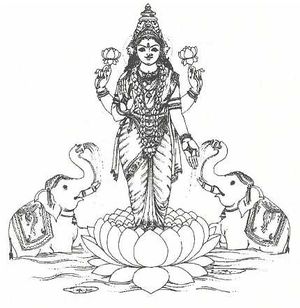Lakṣmi
By Swami Harshananda
Lakṣmi, the goddess of fortune, is more sought after than Sarasvatī, the goddess of learning. She is also represented as the power of multiplicity and the goddess of fortune being the power and consort of Viṣṇu, the preserver. Both of these are equally necessary in the process of preservation.
Difference in Śrī and Lakṣmī[edit]
'Śrī’ or ‘Lakṣmī’, as depicted in the Veda, is the goddess of wealth, fortune, power and beauty. Though, there is a wide scope to suppose that Śri and Lakṣmi are two separate deities. The descriptions of both of them are so identical that we are tempted to conclude that they represent one and the same deity.
Some scholars opine that ‘Śri’ was a pre-vedic deity connected with fertility, water and agriculture. She was later fused with Lakṣmī, the Vedic goddess of beauty.
Incarnations of Lakṣmī[edit]
Lakṣmī being the consort of Viṣṇu, is born as his spouse whenever he incarnates. According to the purāṇas, in her first incarnation she was the daughter of the sage Bhṛgu and his wife Khyāti. She was later born out of the ocean of milk at the time of its churning.
When he appeared as Vāmana, Paraśurāma, Rāma and Kṛṣṇa, she appeared as Padmā (or Kamalā), Dharaṇī, Sītā and Rukmiṇī. She is inseparable from Viṣṇu just as the speech cannot be separated from meaning or knowledge from intellect or good deeds from righteousness. Viṣṇu represents all that is masculine and Lakṣmī represents all that is feminine.
Portraiture of Lakṣmī[edit]
Lakṣmī can be portrayed as follows:
- She is usually described as enchantingly beautiful and standing on a lotus.
- She holds lotuses in each of her two hands. Perhaps it is because of this, that she is named as Padmā or Kamalā.
- She is also adorned with a lotus garland.
- Very often elephants are shown on either sides emptying pitchers of water over her, the pitchers representing celestial maidens.
- Her color is variously described as dark, pink, golden yellow or white.
- While in the company of Viṣṇu, she is shown with two hands only.
- When she is worshiped in a temple, separate temples for Lakṣmī are rather rare, she is shown seated on a lotus throne, with four hands holding padma, śañkha, amrtakalaśa (pot of ambrosia) and bilva fruit.
- Sometimes, another kind of fruit, the Mātuliṅga (a citron) is shown instead of bilva.
- When shown with eight hands, bow and arrow, mace and discus are added. This is actually the Mahālakṣmi, an aspect of Durgā.
Symbology[edit]
An attempt is made here to explain in brief regarding the symbols associated with goddess Lakṣmi.
Complexion[edit]
- If Lakṣmi is pictured as dark in complexion, it denotes that she is the consort of Viṣṇu, the dark god.
- If she is displayed in golden yellow, it shows her as the source of all wealth.
- If white, she represents the purest form of prakṛti (nature) from which the universe has developed.
- The most common is the pinkish complexion which reflects her compassion for creatures, since she is the mother of all.
Hands[edit]
Her four hands signify her power to grant the following:
- Four puruṣārthas - ends of human life
- Dharma - righteousness
- Artha - wealth
- Kāma - pleasures of the flesh
- Mokṣa - beatitude
Lotus[edit]
The lotuses, in various stages of blooming, represent the worlds and beings in various stages of evolution.
Fruits[edit]
The fruit stands for the fruits of our labors. However-much we may toil and labor, unless the Mother is gracious enough to grant the fruits of our labor, nothing will be of any avail. Different fruits denote different meanings. They are:
- If the fruit is coconut with its shell, kernel and water, it means that from her originate the three levels of creation, the gross, the subtle and the extremely subtle.
- If it is a pomegranate or a citron, it signifies that the various created worlds are under her control and she transcends them all.
- If it is a bilva fruit, which is not very tasty or attractive but extremely good for health, it stands for mokṣa, the highest fruit of spiritual life.
Amṛtakalaśa[edit]
Amṛtakalaśa also signifies the same thing that she can give us the bliss of immortality.
Owl[edit]
In some of the sculptural depictions of Lakṣmi, the owl is shown as her carrier vehicle. It looks rather odd and strange that the goddess of fortune and beauty should have an ugly bird, the very sight of which is considered inauspicious, as her carrier.
The word in Sanskrit for the owl is Uluka. Uluka is also one of the names of Indra, the king of gods. Hence Lakṣmī being the goddess of fortune could not have found a better person to ride on, than the king of gods. Indra is personification of all wealth, power and glory that a living being can aspire for in life. At the same time, here is a warning administered to the seekers of secular wealth instead of spiritual wealth, by comparing the glory of Indra to the ugliness of an inelegant and partially blind bird.
Based on the beautiful description given in the Bhagavadgitā[1] we can compare owl to the sthitaprajña, the man of steady wisdom. Then, the symbol would mean that Mother Lakṣmī is the mistress of spiritual wisdom. It also denotes a different meaning that:
‘Do not shut out your eyes to the light of wisdom coming from the sun of knowledge!’
Considering whole mankind, the all-compassionate Mother has kept this personification of ignorance under her control.
References[edit]
- ↑ Bhagavadgitā 2.69
- The Concise Encyclopedia of Hinduism, Swami Harshananda, Ram Krishna Math, Bangalore

